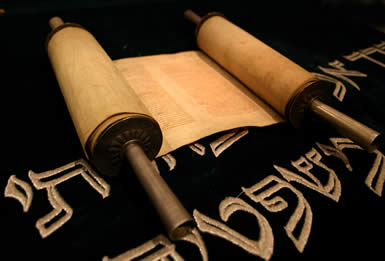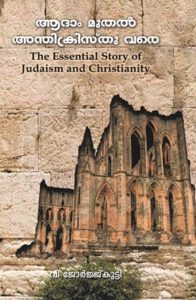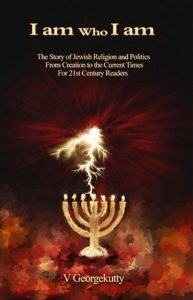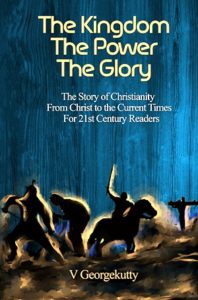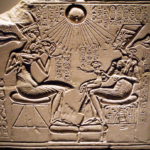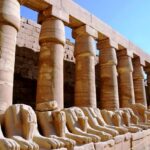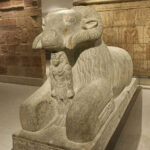“People speak sometimes about the “bestial” cruelty of man, but that is terribly unjust and offensive to beasts, no animal could ever be so cruel as a man, so artfully, so artistically cruel.”
― Fyodor Dostoyevsky
Introduction
The Babylonians, the Assyrians, the Egyptians and the Persians were among the greatest empires of the ancient world. They had slaughtered people, conquered lands and accumulated immense riches and power. They had built massive garrisons, monolithic cities and monumental palaces as symbols of their invincibility. Eventually those empires crumbled, their armies were trounced, their cities were leveled and their palaces were turned into rubble heaps. Today, all these lie underneath thousands of years of sludge, slime and sand. Their cultures and clans were lost to history. Yet, one of their less mighty contemporaries survived. The Hebrews (known also as Israelites or, later, Jews) outlived those great empires.
In Part-I we discussed some of the common features of the Abrahamic Religions – Judaism, Christianity and Islam. In this part, I seek to look briefly into the history of the religion of the Hebrews.
Judaism
The most significant contribution of the Hebrews to humankind was the revolutionary idea of monotheism (belief in one God). The Hebrew God was called Yahweh around whom its religion (Judaism) evolved.
 |
| The Wailing Wall |
We learn the early history of the Hebrews primarily from their scripture, Torah. (The first five books of the Old Testament Bible). The Hebrew religion begins in Abraham. He was a native of Ur, an ancient city of Sumer. After his father died, Yahweh commanded Abraham to destroy all the idols of the gods of his ancestors. Yahweh wanted Abraham to leave his native place and people. God said, “Go from your country, your people and your father’s household to the land I will show you” (Genesis 12:1). The land that Yahweh was to show Abraham was Canaan (roughly located in the same territory as modern-day Israel). God promised Abraham, “To your descendants, I will give this land” (Genesis 12:7). Thus, Canaan became the ‘Promised Land’for the descendants of Abraham and Hebrews became the ‘People of the Land’.
In about 1850 BCE Abraham left Ur and travelled to the land of Canaan. Canaan was not a vacant territory. It was already inhabited by miscellaneous races and tribes. They lived in independently governed walled cities. When Abraham and his family moved into the ‘Promised Land’, the Canaanites accommodated them.
Yahwehhad also promised Abraham, “You will be the father of a multitude of nations” (Genesis 17:4). However, Abraham and his wife Sarah had no children. It looked Sarah was barren. So, Sarah gave her Egyptian slave girl Hagaras a concubine to Abraham in order to preserve the Abrahamic bloodline as was the usual practice those days. Hagar conceived and gave birth to a son who was named Ishmael.Since Sarah still had no children, she turned jealous and the rivalries between the wife and concubine began.
Eventually Sarah too became pregnant and gave birth to a son who was named Isaac. With the arrival of Isaac, the hostilities between the women turned more intense. Sarah made Abraham sent away Hagar and her infant son into the desert. Abraham was saddened by the turn of events. But he was too much in love with his wife to offend her. So Ishmael and his mother were sent away into the desert. Abraham was in great grief.
God consoled Abraham saying, “But the slave girl’s son I will also make into a nation for he is your child too1” (Genesis 21:12). But Abraham’s troubles did not end. God asked Abraham to sacrifice his only son. He agreed. But at the point when Abraham was to drive the dagger down his son’s throat, God intervened and saved Isaac. In view of Abraham’s absolute submission to God’s commands, Abraham came to be known as the ‘Father of the faithful’.
Isaac grew up and married in due time. His wife Rebecca gave birth to twins – Esau and Jacob. Esau came out first and then came Jacob grasping Esau’s heel. As the first-born, Esau was the favourite of his father and by tradition, the first claimant of his father’s inheritance. But Jacob was the pet of his mother. The mother and son conspired to cheat Esau out of his legitimate rights2.
Jacob married his maternal uncle Laban’s daughters. He served his uncle for seven years hoping to marry his younger daughter Rachel. But Laban was also wily like his sister Rebecca (Jacob’s mother who had cheated her own elder son). After seven years, he tricked Jacob into marrying his elder daughter Leah, and demanded him to serve another seven years if he wanted the hand of Rachel in marriage. Eventually Jacob ended up sweating for some fourteen long years and marrying both sisters. In a while God asked Jacob to leave the household of Laban to return to his own native land3.
Jacob had twelve sons by his two wives and by their handmaidens. God had once told Jacob, “Your name is Jacob, but you will no longer be called Jacob; your name will be Israel.” (Genesis 35:10). From the twelve sons of Israel (Jacob) originated the “Twelve Tribes of Israel“. Thus, the descendants of Jacob together came to be called also as Israelites.
Jacob had discriminated not only against his children but also against his wives. Joseph, the 11th son was the darling of Jacob. He was the firstborn of his favourite second wife, Rachel. This angered Joseph’s elder brothers. When the opportunity came, they secretly sold Joseph into slavery and lied to their father that Joseph was killed by wild animals. Joseph was taken to Egypt as a slave. But he soon rose to become the vizier – the second most powerful man in Egypt after the Egyptian ruler Pharaoh.
Although God would describe Canaan as “a land flowing with milk and honey” (Exodus 3:17), the land did not flow so easily with milk and honey when Abraham and his family went to live there. The terrain was rough and the climate dry. Abraham and his descendants had to struggle hard to eke out a living. Then there was a long period of drought. Famine struck Canaan. Jacob heard that Egypt’s new vizier had foreseen the drought and had arranged to stockpile food grains during the years of abundant harvests. So, Jacob sent his sons to Egypt to buy food. Joseph recognized his brothers. A lot of hugging and sobbing followed in a while. Eventually, in about 1700 BCE, the whole family of Jacob immigrated to Egypt. In Egypt, the Israelites multiplied to become a massive population.
The Pharaohs of Egypt were kindly towards the Israelites while Joseph and his reputation remained alive. As time passed and rulers changed, a pharaoh “who did not know Joseph” enslaved the Israelites. The Israelites were persecuted and had to do hard labour for their masters. Life was becoming increasingly painful for the Israelites. The Pharaoh felt threatened by the rising Israelite population. So the Pharaoh ordered, “Every Hebrew boy that is born, you must throw into the Nile, but let every girl live.”(Exodus 1:22).
God intervened and deputed Moses, a Hebrew boy who was saved from the Nile by Pharaoh’s daughter to be brought up in the palace. Through Moses God released the Israelites from their Egyptian bondage and led them on their journey back to the ‘Promised Land’ of Canaan that they had left some five hundred odd years ago. This journey from Egypt to Canaan came to be called the Exodus.
The distance by the shortest route from Egypt to Canaan was some 250 kilometres. Yet the Israelites had to live as nomads in the Sinai Peninsula for forty long years. At the Mount of Sinai, the Israelites received their Divine Law through Moses in the form of the ‘Ten Commandments’ inscribed on two stone tablets. Moses died before the Israelites could enter Canaan. In fact, most of those who started their journey did not have the good fortune to enter the Promised Land4.
After the death of Moses, in about 1200 BCE, God ordered Joshua, the successor of Moses, to lead the Israelites across the Jordan River to take possession of the Promised Land. The Israelites considered the local Canaanites as encroachers on their promised land. They believed that it was the will of their God that they exterminate the encroachers. This time around, the land indeed ‘flowed with milk and honey’, thanks to the sweat and blood of the Canaanites whose generations had toiled on that land while the Israelites were away in Egypt. The stage was set for the commencement of the first big and brutal ‘Holy War’ of Judaism.
The sixth Commandment said, “Thou shalt not kill”. However, God now told His people, “I shall exterminate these people” (Exodus 23:23). In a series of bloody military campaigns, Canaanite men, women, children and even their cattle were ruthlessly massacred. Most Canaanite cities were burned down and reduced to rubble heaps. About the capture of the Canaanite city Ai, the Bible says, “When Israel had finished killing all the men of Ai in the fields and in the wilderness where they had chased them, and when every one of them had been put to the sword, all the Israelites returned to Ai and killed those who were in it. Twelve thousand men and women fell that day—all the people of Ai. … So Joshua burned Ai and made it a permanent heap of ruins, a desolate place to this day. He impaled the body of the king of Ai on a pole and left it there until evening”(Joshua 8: 24,25,28,29). It was just the beginning. The ‘Holy’ land wars of the Israelites would continue for another two hundred odd years…
The Israelites finally started settling down on their Promised Land. For the first time in history, the traditional nomadic herders established a Kingdom of the Hebrew people. King Saul was chosen by God as the first ruler of the United Kingdom of Israel.
God had told the King, “Go and attack the Amalekites! Destroy them and all their possessions. Do not have any pity. Kill their men, women, children, and even their babies. Slaughter their cattle, sheep, camels, and donkeys.” But the King did not kill exactly as commanded. “Every Amalekite was killed except King Agag. Saul and his army let Agag live, and they also spared the best sheep and cattle” (1 Samuel 15: 8-9). And God was angry since the King was not fully obedient to His commands. So God decided to end the rule of King Saul.
God chose David, a bold and athletic shepherd boy, as Saul’s successor, instead of Jonathan, the King’s son. In about 1000 BCE, King David, conquered Jerusalem from the Canaanite tribe, Jebusites (Until then Jerusalem was known as Jebus). Jerusalem thus became the ‘City of David’ and the capital of his kingdom. And King David became the most celebrated Hebrew hero5.
David had a deep desire to build a great temple in Jerusalem for his God. But God dissuaded David from undertaking the project. God told David, “You have shed much blood, and have waged great wars; you shall not build a house to My name, because you have shed so much blood on the earth before Me.” (1 Chronicles 22:8). Thus, King Solomon, the son of King David, built a massive and magnificent Jewish Temple in Jerusalem on Mount Moria6.
Solomon’s Temple made Jerusalem the holiest place on earth for the Israelites. The Israelites had thus become the ‘People of the Land’ and the ‘People of the Temple’. From then on, it was impossible for the Israelites to think of a life apart from their ‘Holy Land’ and their ‘Holy Temple’.
The twelve tribes of Israel originating from of the twelve sons of Jacob settled down within the united Hebrew kingdom of Israel. Yet each tribe chose to live together and preserve its separate identity. Ten of the twelve tribes had inhabited the northern part of the kingdom and two in the southern part.
When King Solomon died, (between 926 and 922 BCE), the ten northern tribes refused to submit to Solomon’s son, Rehoboam. They revolted. That revolt sounded the death knell of a united Hebrew Kingdom of all twelve tribes. The ten northern tribes broke away, founded a kingdom of their own, and named it ‘Israel’. Jeroboam was anointed the king of Israel. It built its capital in the city of Samaria. The remaining two southern tribes became the second Hebrew kingdom under king Rehoboam. This kingdom was named ‘Judah7’. Judah (also Judea) retained Jerusalem as its capital.
By 746 BCE, the northern kingdom was degenerating into a state of anarchy. Between 746 and 736 five kings sat on the throne of the kingdom of Israel. The weakening of the kingdom fired the ambitions of the Assyrian king Tiglath-Pileser-III. He itched to annex Israel to his expanding empire. In 722 BCE, the Northern kingdom (Israel)was conquered by his successor Sargon-II. The Assyrians forced the ten Hebrew tribes of Israel to scatter throughout the Assyrian empire and assimilate with non-Jewish sects at the places they settled. With that, those ten tribes disappeared permanently from history. And they have come to be called “The Ten Lost Tribes of Israel.”
Obviously, the conquest of the northern kingdom scared Judah. It feared that the Assyrians would now turn their armies towards their kingdom. In 701 BCE, the Assyrian king Sennacherib had laid siege to the city of Jerusalem. But Jerusalem did not fall. According to Sennacherib’s own account, Hezekiah, the king of Judah, was “shut up in the city like a caged bird8“. Had the Assyrians conquered Jerusalem, the remaining two tribes of Israel too would have suffered the fate of the “The Ten Lost Tribes of Israel.”
But the respite of Judah did not last long. In the course of the power struggles between the Assyrians, Babylonians and Egyptians, Judah became a tribute state (a state under protection by another for a payment) of Egypt. When the Babylonians defeated the Egyptians in 605 BCE, Judah became a tribute state to Babylon. In 601 BCE when the Babylonians suffered a defeat, Jehoiakim, the king of Judah, defected to the Egyptians. It was a shifting of loyalties that spelt disaster for the Hebrews. The Babylonians would not let the treachery of King Jehoiakim go unpunished.
In 597 BCE, the Babylonian king, Nebuchadnezzar, raised an expedition to punish Judah. The new King at Jerusalem was Jehoiachin, son and successor of the defector King Jehoiakim. Nebuchadnezzar did not care. He dethroned Jehoiachinand carried him captive to Babylon, along with his mother, his wives, his officers, all of his army and all of the wealthy, professionals and artisans. No one was left in Jerusalem and Judah except the poor and the unskilled. Nebuchadnezzar appointed the uncle of Jehoiachin, Zedekiah, to be a puppet king in Judah. An estimated 10,000 to 13,000 Jews were exiled to Babylon in the aftermath.
But the defections and its attended disasters did not end. The newly appointed King Zedekiah defected from the Babylonians. Nebuchadnezzar was enraged and responded with another expedition in 588 BCE. In 586 BCE Jerusalem was conquered and the city and the Jewish Temple were destroyed. Nebuchadnezzar caught King Zedekiah and forced him to watch the murder of his sons. That was the last thing Zedekiah would see since Nebuchadnezzar then blinded Zedekiah and took him to Babylon. The destruction of Jerusalem and the Holy Temple led to more deportations of the Jews to Babylonia.
With it, more or less the entire Hebrew population lost their association with their Promised Land and their Holy Temple. However, the two tribes deported to Babylonia survived. Unlike the Assyrians, the Babylonians did not force their captives to scatter and be lost among the native people. They moved the Jewish population together to a single location. This enabled the Jews to set up an exclusive community on foreign soil and retain their religious and national identities. They held on to their faith in the God of their ancestors. However, their life in such exclusive Jewish communities marked the first ‘ghetto’ experience of the Jewish population9.
The Jews in exile were in deep anguish. As had been their tradition, they were unforgiving in their attitudes. Their murderous thoughts come out loud and clear in the Psalms. They sang, “O Babylon, you will be destroyed. Happy is the one who pays you back for what you have done to us. Blessed is the one who grabs your babies and smashes them against a rock” (Psalm 137:8-9).
Decades went by. Eventually Babylon was conquered by the Persians. In 538 BCE, the Persian King Cyrus – II (Cyrus the Great) granted permission to the Jews to return to Jerusalem and rebuild their Temple. Thus, some sixty years after their exile, the Israelites traced their way back to their holy land. It was a peaceful version of the exodus of their ancestors from Egyptian slavery. On the previous night of the Egyptian exodus, the first-born of every Egyptian household was massacred to make the Pharaoh relent to the release of the Israelites. Now, King Cyrus-II of Persia happily allowed them to return to Jerusalem.
The first group of 42,000 plus Jews, led by Zerubbabel, whom the Persian king had appointed the Governor of Judea, returned to Jerusalem. But just as their ancestors found Canaan occupied, the Jewish returnees from Babylonia too found Jerusalem occupied by other people. Hostilities broke out between the Babylonian returnees and the occupants of Jerusalem. Amidst it, Zerubbabel laid the foundation of the Second Temple in Jerusalem (giving it the name Temple of Zerubbabel).
It took two years for the work on the foundation of the Temple to be completed. Then hostilities arose between the Jews and the Samaritans. The Persian king Artaxerxes ordered the halting of the Temple construction. For the next seventeen years, no construction activities took place at the temple site. It was resumed later and the Temple was eventually completed in 516 BCE. The Jews gathered together at Jerusalem for the consecration of the Temple. Zerubbabel, the man who toiled for the reconstruction of the Temple, is not found mentioned in the Bible either during the consecration ceremonies or thereafter.
While the Jews returned from exile and were rebuilding the Temple at Jerusalem gave him comfort, Nehemiah, an officer in the palace of Persian king Artaxerxes was a sad man. Seeing his glum face, the king asked Nehemiah the reason. Nehemiah responded, “Why should my face not be sad, when the city, he place of my fathers’ tombs, lies waste, and its gates are burned with fire” (Nehemiah 2:3). So the King sent Nehemiah back to Jerusalem as its governor. Nehemiah reconstructed the city and rebuilt its walls. Because of the fear of enemies, people worked with just one hand while with the other they held their swords. Nehemiah remained the governor of Jerusalem city for twelve years.
The battles for control over Judah and Jerusalem continued and the territories continued to change hands. King Herod the Great (74/73 BCE – 4 BCE) reigned as the Roman client-king of Judea from 37 BCE to 04 BCE. He was unhappy with the Second Temple. He felt that the Temple was built like a fortress. Also, the new Temple was shorter than Solomon’s Temple by about 90 feet10.
So, in 19 BCE, King Herod started rebuilding the Jerusalem Temple. The King died in 04 BCE. But the work was not entirely finished until 63 CE11. And this renovated Temple would stand only for just SEVEN years after its completion.
In 70 CE, the Romans conquered Jerusalem. They destroyed the city and burned down the Temple. All that remained of the Temple was the great external (retaining) walls. A portion of it, known as the Western Wall (The Wailing Wall), still remains. For the Jews, the Wailing Wall is the most sacred prayer spot.
Thirty years after the destruction of the second temple, the Herodian dynasty came to an end. But bloodshed over Jerusalem did not. Jerusalem came under the reign of various conquering rulers.
In 130 CE, the Roman Emperor Hadrian visited the ruins of Jerusalem. He rebuilt the city and renamed it Aelia Capitolina (135 CE). (This part is now known as the “Old City”). He prohibited some Jewish practices. The Jews revolted. Hadrian used massive force to put down the Jewish rebellion. Estimates say that some half a million Jews died in the rebellion.
The Roman Emperor Constantine rebuilt Jerusalem as a Christian centre of worship. The Christians ruled Israel for some 300 years. They made it illegal for Jews to live in Jerusalem.
In 638 CE Muslims conquered Israel and Jerusalem. Though they allowed Jews to move back into Jerusalem, they also built their mosques atop Judaism’s holiest site — the Temple Mount (Mount Moriah).
In 1099, Christians returned to Jerusalem after defeating the Muslims. They killed both Muslims and Jews in Jerusalem. Then the Turks conquered Jerusalem in 1517, and ruled it for 400 long years. The Turks lost control after the end of World War-I. In 1917, England defeated the Turks and conquered Israel and Jerusalem. Thus, Palestine became a British Mandate12.
As the battles for their ‘Holy Land’ raged, descendants of Abraham were getting scattered around the world. The age of the ‘Wandering Jew’ had begun. And this period of exile would extend to nearly two thousand years. Yet, the Jewish diaspora always dreamed of a day it would return to the ‘Promised Land’.
The Jews received no happy welcome in most places they went. Yet they managed to struggle and survive for centuries as a nationless population. But things turned difficult for them by late nineteenth century. This was period of intense nationalism. New nation-states were emerging in Europe creating national identities for its native citizens. But the Jews scattered across the globe had no nation to claim as their own. They were looked down upon as ‘the Other’ by the very people whom they had once despised as the ‘Gentiles’. Now, the ‘Gentiles’ had national identities in which they took pride. The Jews had none. “for the living, the Jew was a dead man; for the natives, an alien and vagrant; for property holders, a beggar; for the poor, an exploiter and a millionaire; for the patriot a man without a country.” (Leon Pinsker, as quoted by Karen Armstrong in her book ‘Holy Wars’). Anti-Semitismraised its ugly head13. Severe persecutions started. Russia under reign of the Tsars was particularly cruel towards the Jews.
The Jewish diaspora tried to return to Jerusalem, their holy city. Many risked their lives and returned to their homeland. The Zionist movement aimed at facilitating the return of the Jews to their Promised Land (Palestine) emerged. In 1982, the first ‘Aliyah’ reached Palestine14.
Christian violence against the Jews was increasing. After being persecuted in Tsarist Russia when the Jews started migrating across Western Europe, the antipathy towards them spread into other parts of Europe. Jewish leaders were now convinced that the Jews had to acquire a nation of their own if they were to lead a free and dignified life.
The second Aliyah had already started pouring in to Palestine by 1902. More such waves continued later. They bought land that belonged to the Arab landlords who lived far away leaving the land to their tenants. The returning Jews drove out the Palestinian tenants and established colonies and kibbutzim (A collective settlement). But only about six per cent of the land was acquired by the Jews this way. There was still no serious enmity between the Jews and the Arabs. The Jews remained a miniscule minority until 194815.
Then came the Nazi Holocaust associated with World War II (1939-1945) in which around six million Jews perished in the hands of Hitler’s Army. It was, perhaps, the most horrendous ethnic cleansing in the annals of human history. (More on this in the next part on Christianity). The Zionist movement had been gathering strength. The Jewish leaders started their intense lobbying with world powers for their cause of a Jewish homeland. In 1917, the Russian Zionist Chaim Weizmann secured the formal support of Great Britain on the initiative of the then British Foreign Secretary Arthur Balfour, in the form of what would come to be known as Balfour Declaration. The declaration dated November 2, 1917 stated, “His Majesty’s Government views with favour the establishment in Palestine of a national home for the Jewish people….” It was a first step.
In 1948, Palestine, then under British Mandate, was divided to create the modern Jewish State of Israel. On May 14, 1948, in a ceremony held in the Tel Aviv Museum, the State of Israel was proclaimed by David Ben-Gurion. The new state had the backing of the United Nations, the United States and Soviet Union. The British were unrelenting in the beginning in spite of the Balfour Declaration. And the surrounding Arab states simply could not believe or accept what was happening. The Palestinians argued that they just could not be kicked out of the lands they had been occupying for a thousand years or more. They vowed to wipe out the budding state of Israel.
As the British control over Palestine came to an end on May 15, 1948, five Arab armies invaded Israel. It was generally apprehended that the Arab Goliath would run over the little David, Israel16. But it was simply a life and death situation for the Israelites. The Israelite army fought valiantly, violently and professionally. To the surprise of all, the Israelites drove the Arab armies back. History was repeating itself. Blood once again flowed profusely over the Holy Land.
Yet, the issue of Jerusalem remained. In its 1947 plan for the partition of Palestine, the United Nations had proposed that Jerusalem would be a city under international administration. Following the 1948 Arab-Israeli War, Jerusalem was divided. The Western half of the ‘New City’ became part of the newly formed state of Israel. The eastern half, along with the ‘Old City’, was annexed by Jordan.
The Jordanians either killed or drove out all the Jews who lived within the walls of the ancient city. They destroyed and vandalized the sacred places of the Jews. The Jews were banned from visiting the Wailing Wall to pray. Israel had to be contented with a capital it established outside of the walls of their ancient Temple city. For Israel, this was simply unacceptable. Israel used its firepower to settle the matter in the spring of 1967.
During the ‘six-day war’ of 1967 between Israel and the Arab armies, Israel captured East Jerusalem (Old City). People died, homes were destroyed and inhabitants were expelled. The ancient city of Jerusalem once again became the capital of the Jewish homeland some 2800 years after King David first made it his capital and some 2000 years after the city and the Jewish Temple were destroyed by the Romans. Under Israeli control, members of all religions are largely granted access to their holy sites in Jerusalem. However, there are restrictions for both the Jews and the Muslims at certain specific sites17.
Conclusion
During its long history, Jerusalem has been destroyed twice, besieged twenty three times, attacked fifty two times, and captured and recaptured forty four times. Israelites might now feel happy and satisfied. But, for Palestinians, Israel turned out to be one of their greatest calamities. In the aftermath of the Arab-Israel conflicts, some 750,000 Palestinians were driven out of their homeland. Their descendants now numbering over 50,00,000 would apparently remain refugees forever on the land they and their forefathers had inhabited for centuries. As Karen Armstrong puts it, “The Wandering Jew had been replaced by the Wandering Palestinian….”
The Jews who had suffered under the anti-Semitism of the Christian West for a thousand years now have new enemies in the East in the form of the Arabs who surround them. The deadly conflicts would continue. More battles would rage on the bosom of the ‘Promised Land’. More blood would flow over the sacred soil of the holy land of the Abrahamic faiths. It is bound to be so when faith is mixed with politics. Then, for the Abrahamic Religions, politics had never been something apart from their faith…
Notes:
1It is believed that Islam originated from the ancestry of Ishmael.
2In the Old Testament Bible, we repeatedly encounter parental favouritism. In most cases, the elder sons are side-lined in favour of the younger ones. We saw it in the case of Ishmael and Isaac, and Esau and Jacob. Even among the children of the first couple Adam and Eve, the younger son Abel was preferred by God with the result that he was slain by his jealous elder brother Cain. Jacob favoured his eleventh son Joseph leading to his brothers selling him into slavery. Jacob blessed the younger son of Joseph in spite of Joseph pointing out that the one Jacob was blessing was not his first-born. Sibling rivalries arising out of parental favouritism caused deaths, disquiets and destructions in the Old Testament families.
3Rachel was no less crafty than her father Laban and her aunt Rebecca. She left her father’s home stealing the family idols and used her cunningness to hide it from her father who had come after Jacob to retrieve the idols. Commentators say that the possession of family idols was an evidence of legal right to inheritance of the wealth of the family. Rachel was raised in a family that followed paganism, although as Jacob’s wife she later worshipped the God of Abraham. (Genesis 31)
4Only those who were less than twenty at the commencement of the exodus and probably the priestly tribe of ‘Levi’ besides a few exceptions like Joshua and Caleb, their warrior leaders, would enter Canaan. The Israelites would wander in the Sinai desert until the rest of population who grumbled that it would have been better for them to die in the desert. They had said, “If only we had died in Egypt! Or in this wilderness! Why is the Lord bringing us to this land only to let us fall by the sword? Our wives and children will be taken as plunder. Wouldn’t it be better for us to go back to Egypt?” (Numbers 2:2-3). God responded to it saying, “In this wilderness your bodies will fall—every one of you twenty years old or more who was counted in the census and who has grumbled against me. Not one of you will enter the land I swore with uplifted hand to make your home, except Caleb son of Jephunneh and Joshua son of Nun” (Numbers 14:29-30).
5Today, the ‘Star of David’ is the symbol most commonly associated with Judaism.
6Mount Moriah is the mount on which Abraham offered Isaac as sacrifice to God (Genesis 22). It is identified as the location of the threshing floor of Araunah (Ornan), the Jebusite. ‘David said to him, “Let me have the site of your threshing floor so I can build an altar to the Lord, that the plague on the people may be stopped. Sell it to me at the full price.” Araunah said to David, “Take it! Let my lord the king do whatever pleases him…” But King David replied to Araunah, “No, I insist on paying the full price. I will not take for the Lord what is yours, or sacrifice a burnt offering that costs me nothing.” So David paid Araunah six hundred shekels (15 Pounds or 5.9 Kilograms) of gold for the site.’ (1 Chronicles 21: 22-25). The Temple Mount today covers about 45 acres. It is built around the outcropping of the bedrock under the Dome of the Rock.
7The Hebrew word “Yehudi” (“Jew” in English) is derived from the name Judah, who was one of Jacob’s twelve sons. Judah was the ancestor of one of the tribes of Israel, which was named after him. Originally, the word referred to members of the tribe of Judah, but later it described anyone from the kingdom of Judah (2 Kings. 16:6 etc.).
8According to the Bible, in a miraculous event an angel killed 185,000 men in Sennacherib’s army. It says, “Then it happened that night that the angel of the LORD went out and struck 185,000 in the camp of the Assyrians; and when men rose early in the morning, behold, all of them were dead. So Sennacherib king of Assyria departed and returned home… (2 Kings 19:35-36).
9A ghetto is a part of a city in which members of a minority group live, especially because of social, legal, or economic pressure. The term was originally used in Venice to describe the part of the city to which Jews were restricted and segregated. The word has the meaning waste. Thus, ‘ghetto’ has become an exclusive location where the ‘waste’ of the society is kept.
10The smaller size of the Temple was because of the restrictions imposed by the Persian King Darius the Great.
11It would still be referred to as the ‘Second Temple’, although strictly speaking, Herod’s Temple was the third Temple.
12Mandate: A territory surrendered by Turkey or Germany after World War I and put under the safe custody of some other European power until they are able to stand by themselves.
13Anti-semitisism: The intense dislike for and prejudice against Jewish people.
14The concept of ‘Aliyah’ developed in the Jewish history during their exile in Babylon when the Jews lived hoping and praying for their ‘return’ to their ‘Holy Land’.
15In December 1918, the composition of Palestine population was estimated as follows:
Muslim Arabs : 512,000
Christian Arabs : 61,000
Jews : 66,000
(Source: The Holy Wars by Karen Armstrong)
16A war had raged between the Philistine and Israeli armies. Goliath was a giant Philistine warrior who challenged the Israelites. Israel could find none to accept his challenge. Enter David, the shepherd boy. David used a stone in his sling to knock down the Philistine giant. He rushed forward and cut off his head with the Philistine’s own sword. With it, David became the hero of Israel and eventually their most celebrated King.
17The status of East Jerusalem remains a highly controversial issue. The international community does not recognize the annexation of the eastern part of the city by Israel, and most countries, including the US, maintain their embassies in Tel Aviv.
Click the Links below to read the other parts:
